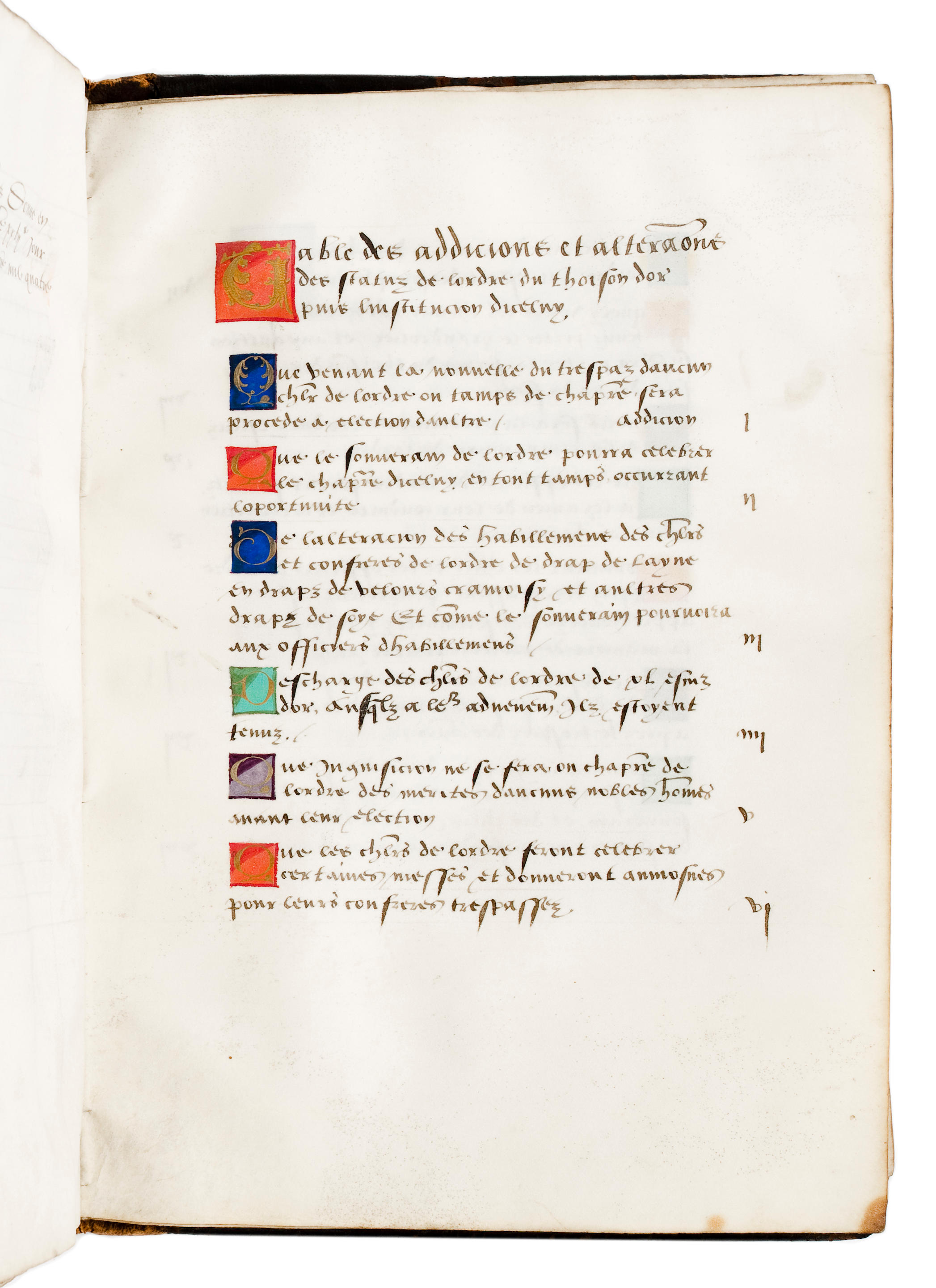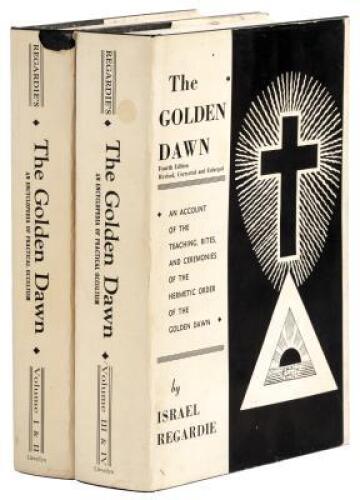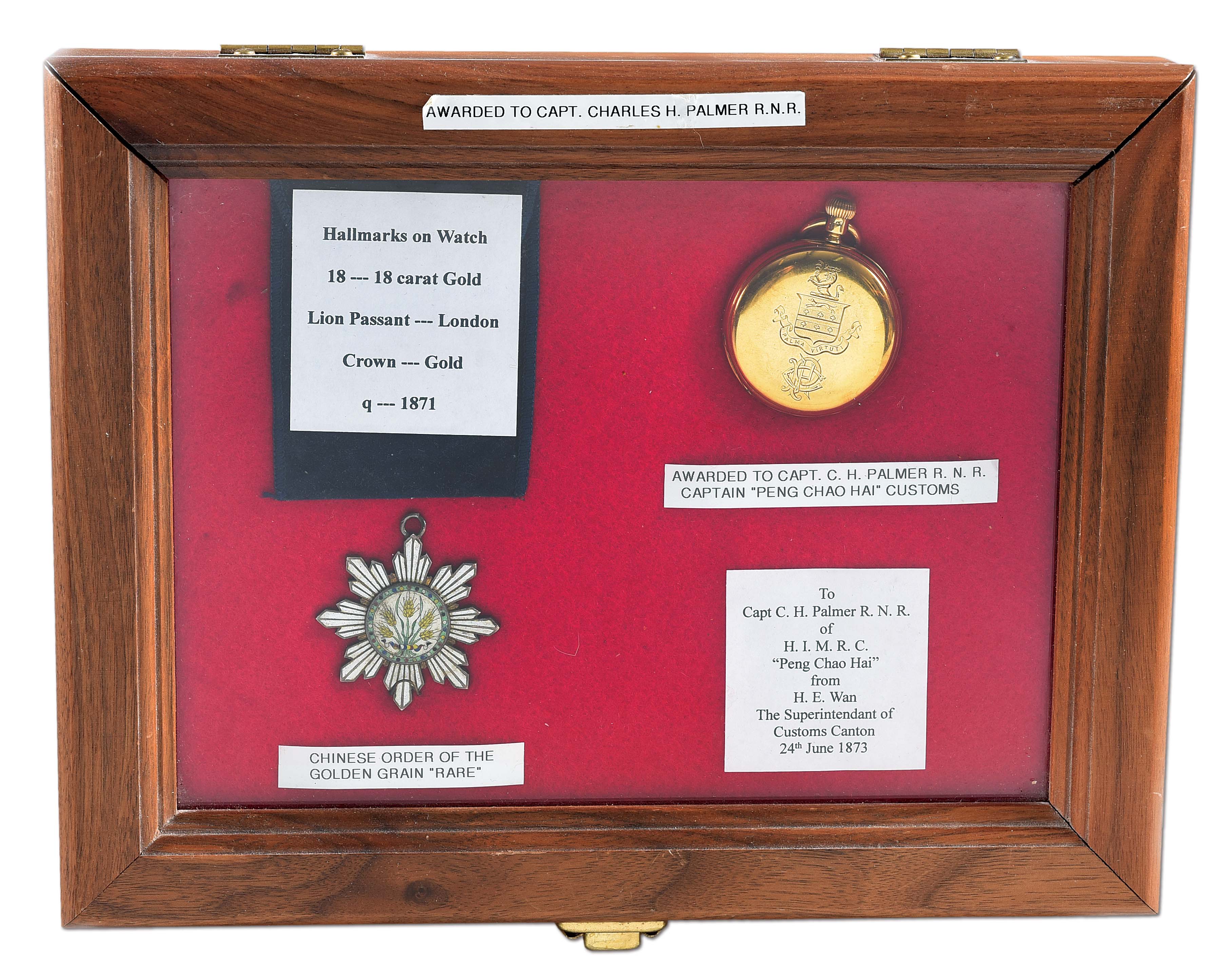Order of the Golden Fleece (Ordre de la Toison d’or). Les ordonnances de l’ordre de la toison d’or. [Antwerp: Willem Sylvius in the Officina Plantiniana, 1559]
The Statutes of the Order of the Golden Fleece, founded by Philippe le Bon, Duc de Bourgogne, in Bruges on the day of his marriage to Isabelle de Portugal, 7 January 1430. It became customary for every Knight to receive a copy of the Statutes regulating the Order, and until 1559 these were manuscripts, written on vellum and illuminated. On the abdication of Charles V, his son Felipe II became head of the Order, and called a meeting (only the 23rd since its inception) in the cathedral of Sint-Baaf, Ghent, on 29 July 1559, and the days following.
Two editions of the Statutes were printed, this one in French, and a Latin translation (by Nicolaus Grudius), as Constitutiones clarissimi ordinis velleris aurei (USTC 404310). All copies of both editions were taken off on vellum and in most the woodcut initials are illuminated; in neither does the printer sign his name. Their publisher was Willem Sylvius (Verwilt), a recent graduate of Louvain university (MA, 31 March 1558), who on 6 May 1558 had obtained a printer’s license. Both editions were completed before the Knights assembled on 29 July 1559, with Sylvius availing himself of the materials of Christophe Plantin. Their impressive typographical quality was noticed by the Council of State, and on 26 July 1559 Sylvius was recommended for the position of official court printer (typographus regius)—an appointment which required the personal approval of Felipe II; it was confirmed sometime before 8 October 1559. Sylvius does not seem to have published anything else in 1559: the first book under his name came out in 1560, and for next few years all of his publications were printed by Plantin and others. When Sylvius belatedly established a press, in 1562, it was furnished with ornamental woodcut initials and types that he purchased in the liquidation auction on 28 April 1562 of Plantin’s establishment.
These peculiar circumstances have only been fully understood since 1990, when Paul Valkema Blouw published a masterly analysis: “Willem Sylvius’s Remarkable Start, 1559-62,” in Quaerendo 20 (1990), pp. 167–206). They account for contradictory entries in the bibliographies, with early authorities crediting the 1559 Statutes to the Plantin press, then Colin Clair and Leon Voet asserting emphatically that Sylvius was their printer and that Plantin had nothing at all to do with them. Voet did not include a description of either edition in his monumental The Plantin Press, providing instead a general entry for the text, in which he discusses the reprints of both editions issued by Balthasar Moretus—these are often claimed to be the originals, but can be distinguished by the presence of two engravings signed by Cornelis Galle a printmaker born in 1576).
It appears that the French version was printed first and the Latin afterwards. All copies of the French version have a printed text of XVI numbered sections. In our copy, and in five others (see below), additional sections numbered XVII-XXI are written in manuscript on the blank leaves of the final quire. These five sections, the first relating to the exclusion of heretics from the Order, are texts promulgated at the assembly on 29 July 1559. Twenty-one sections are printed in all copies of the Latin version, also in the two 1626 Moretus editions, and elsewhere–notably Leibniz’s Codex juris gentium diplomaticus (1693; II, p. 38), and Les ordonnances de l’ordre de la toison d’or (Vienna, 1757).
Copies Printed on Vellum with Manuscript Additions
(1) Gaspar-Joseph de Servais (1735–1807; P.J. Hanicq, Catalogue des livres de la bibliothèque de feu monsieur Gaspar-Joseph de Servais, Malines, 3 October 1808, lot 2661. — unidentified owner - bought in sale (FF 121 - Van Praet) — Henry Huth (1815-1878); Alfred Henry Huth (1850-1910); W.C. Hazlitt & F.S. Ellis, The Huth library. A catalogue of the printed books, manuscripts, autograph letters, and engravings (London 1880), III, p.1065; Sotheby Wilkinson & Hodge, Catalogue of the famous library of printed books, illuminated manuscripts, autograph letters and engravings collected by Henry Huth, and since maintained and augmented by his son Alfred H. Huth, Fosbury Manor, Wiltshire; the printed books and illuminated manuscripts. Sixth portion, London, 11-18 July 1917, lot 5429 — J. & J. Leighton, London - bought in sale (£19) — James Tregaskis, Caxton Head Catalogue 796: Rare and interesting books, autograph letters and documents including recent purchases from the Huth Library - October 15, 1917 (London 1917), lot 183 (£52) — Parke Mayhew Pittar (1857-1918); Sotheby Wilkinson & Hodge, Catalogue of valuable books and manuscripts being the second and concluding portion of the library of the late P.M. Pittar, Esq. of 14, Cleveland Square, Hyde Park, W. (sold by order of the executors), London, 4-7 November 1918, lot 674 — Maggs Bros, London - bought in sale (£7 10s); their Catalogue 374: Rare and beautiful books and manuscripts (London 1919), item 275. Current location not traced.
(2) Paris, Bibliothèque nationale de France, Vélins 1186.Van Praet, op. cit., p.142; cf. Léopold Delisle, Inventaire alphabétique des livres imprimés sur vélin de la bibliothèque nationale (Paris 1877), p.117 no. 1186 (“vers 1559”).
(3) Justin, comte de MacCarthy-Reagh (1744–1811; Notice abrégée des livres imprimés sur vélin de la bibliothèque de feu M. le comte de Mac-Carthy (Paris 1815), no. 226; Debure frères, Catalogue des livres rares et précieux de la bibliothèque de feu M. le comte de Mac-Carthy Reagh, Paris, 27 January–5 May 1817, lot 1240. — De Bure, Paris - bought in sale (FF72); Debure frères, Catalogue des livres rares et précieux … provenant de la vente de feu M. Le Comte de Mac-Carthy-Reagh a vendre aux prix marqués à chaque article (Paris 1817), p.20 item 1240 — Arthur Auguste Brölemann (1826-1904); Catalogue des manuscrits et livres rares de la bibliothèque d’Arthur Brölemann (Lyon 1897), no. 191; Henry-Auguste-Brölemann (1775-1869); Madame Étienne Mallet; Sotheby & Co., Catalogue of a collection of very important illuminated manuscripts and fine printed horae, with a few early illustrated books, formed during the early part of the sixteenth century by Henri Auguste Brölemann, and now sold by order of the present owner, his great-grand-daughter and heiress, Madame Etienne Mallet, London, 4-5 May 1926, lot 177 — unidentified owner - bought in sale (£24) — Sotheby & Co., Catalogue of important historical, medieval and literary mss., valuable printed books, Oriental miniatures, mss. and printed books, London, 20-21 December 1948, lot 277 — Adrian Leigh McLaughlin (1910-1979); Sotheby’s Monaco SA, Livres précieux provenant de la bibliothèque de Major Adrian McLaughlin, Monte Carlo, 7-8 October 1980, lot 1893 — unidentified owner - bought in sale (FF 75,000). Current location not traced.
(4) Charles Chardin (1742–1826; Leblanc, Catalogue de livres précieux, manuscrits et imprimés sur peau-vélin, du cabinet de M. **, Troisième partie. Imprimés sur vélin (Paris 1811), p. 166, lot 55. — Treuttel & Würtz, Strasbourg and Paris (S. Sotheby, The Entire and Extensive Library of an Amateur of Distinction [but Treuttel & Würtz], London, 12–24 June 1817, lot 1113), purchased by — Robert Triphook, London (£2 2s). Current location not traced.Van Praet, op. cit., IV, p.142.
(5) Laurent Beyerlinck (1578–1627; inscription “Laur. Beijerlinck”). — unidentified owner, inscription “Di Nicolai de Weert et di tutti li boni compagni” on title-page — Brussels, Royal Library, II 17.683 A.Blouw, op. cit., p.173 (“contains the additional chapters in manuscript, legalized by the Clerk of the Order”).
The same large center medallion decorating the covers of the Bibliotheca Brookeriana copy is found on the British Library’s copy of the 1559 Latin version (C.41.f.11).
4to (254 x 169 mm). Roman type, 26 lines. collation: A–L4: 44 leaves (L2–4 blank, but here accomplished with manuscript text of additional chapters 17–21). Woodcut initials illuminated in gold with leafy backgrounds in red, green, and blue; index on Hiii expanded in manuscript to include the additional chapters. (Very occasional light marginal finger-soiling or natural discoloration.)
binding: Antwerp paneled polished brown calf (262 x 178 mm), ca. 1560, gilt fillet around sides, inner rectangular frame of 2 gilt fillets, fleurons at outer corners, large gilt central arabesque medallion in negative producing calf strapwork design against gold background, flat spine, bands of gilt leafy tools between double gilt fillets, compartments filled with a gilt fleuron, paper pastedowns, vellum linings, gilt edges. (Extremities rubbed, joints repaired.)
provenance: Original owner unidentified (blank leaves in final quire accomplished with five additional chapters in contemporary manuscript) — “a la vendue de mr. de Seris. 1300” (inscription on flyleaf; unidentified). acquisition: Purchased from Pierre Berès, Paris, 1975.
references: BT 2257; STCV 12924141; Van Praet, Catalogue des livres imprimés sur vélin de la Bibliothèque du roi, V, pp. 141–142 no. 157 (citing two copies with manuscript additions)
Order of the Golden Fleece (Ordre de la Toison d’or). Les ordonnances de l’ordre de la toison d’or. [Antwerp: Willem Sylvius in the Officina Plantiniana, 1559]
The Statutes of the Order of the Golden Fleece, founded by Philippe le Bon, Duc de Bourgogne, in Bruges on the day of his marriage to Isabelle de Portugal, 7 January 1430. It became customary for every Knight to receive a copy of the Statutes regulating the Order, and until 1559 these were manuscripts, written on vellum and illuminated. On the abdication of Charles V, his son Felipe II became head of the Order, and called a meeting (only the 23rd since its inception) in the cathedral of Sint-Baaf, Ghent, on 29 July 1559, and the days following.
Two editions of the Statutes were printed, this one in French, and a Latin translation (by Nicolaus Grudius), as Constitutiones clarissimi ordinis velleris aurei (USTC 404310). All copies of both editions were taken off on vellum and in most the woodcut initials are illuminated; in neither does the printer sign his name. Their publisher was Willem Sylvius (Verwilt), a recent graduate of Louvain university (MA, 31 March 1558), who on 6 May 1558 had obtained a printer’s license. Both editions were completed before the Knights assembled on 29 July 1559, with Sylvius availing himself of the materials of Christophe Plantin. Their impressive typographical quality was noticed by the Council of State, and on 26 July 1559 Sylvius was recommended for the position of official court printer (typographus regius)—an appointment which required the personal approval of Felipe II; it was confirmed sometime before 8 October 1559. Sylvius does not seem to have published anything else in 1559: the first book under his name came out in 1560, and for next few years all of his publications were printed by Plantin and others. When Sylvius belatedly established a press, in 1562, it was furnished with ornamental woodcut initials and types that he purchased in the liquidation auction on 28 April 1562 of Plantin’s establishment.
These peculiar circumstances have only been fully understood since 1990, when Paul Valkema Blouw published a masterly analysis: “Willem Sylvius’s Remarkable Start, 1559-62,” in Quaerendo 20 (1990), pp. 167–206). They account for contradictory entries in the bibliographies, with early authorities crediting the 1559 Statutes to the Plantin press, then Colin Clair and Leon Voet asserting emphatically that Sylvius was their printer and that Plantin had nothing at all to do with them. Voet did not include a description of either edition in his monumental The Plantin Press, providing instead a general entry for the text, in which he discusses the reprints of both editions issued by Balthasar Moretus—these are often claimed to be the originals, but can be distinguished by the presence of two engravings signed by Cornelis Galle a printmaker born in 1576).
It appears that the French version was printed first and the Latin afterwards. All copies of the French version have a printed text of XVI numbered sections. In our copy, and in five others (see below), additional sections numbered XVII-XXI are written in manuscript on the blank leaves of the final quire. These five sections, the first relating to the exclusion of heretics from the Order, are texts promulgated at the assembly on 29 July 1559. Twenty-one sections are printed in all copies of the Latin version, also in the two 1626 Moretus editions, and elsewhere–notably Leibniz’s Codex juris gentium diplomaticus (1693; II, p. 38), and Les ordonnances de l’ordre de la toison d’or (Vienna, 1757).
Copies Printed on Vellum with Manuscript Additions
(1) Gaspar-Joseph de Servais (1735–1807; P.J. Hanicq, Catalogue des livres de la bibliothèque de feu monsieur Gaspar-Joseph de Servais, Malines, 3 October 1808, lot 2661. — unidentified owner - bought in sale (FF 121 - Van Praet) — Henry Huth (1815-1878); Alfred Henry Huth (1850-1910); W.C. Hazlitt & F.S. Ellis, The Huth library. A catalogue of the printed books, manuscripts, autograph letters, and engravings (London 1880), III, p.1065; Sotheby Wilkinson & Hodge, Catalogue of the famous library of printed books, illuminated manuscripts, autograph letters and engravings collected by Henry Huth, and since maintained and augmented by his son Alfred H. Huth, Fosbury Manor, Wiltshire; the printed books and illuminated manuscripts. Sixth portion, London, 11-18 July 1917, lot 5429 — J. & J. Leighton, London - bought in sale (£19) — James Tregaskis, Caxton Head Catalogue 796: Rare and interesting books, autograph letters and documents including recent purchases from the Huth Library - October 15, 1917 (London 1917), lot 183 (£52) — Parke Mayhew Pittar (1857-1918); Sotheby Wilkinson & Hodge, Catalogue of valuable books and manuscripts being the second and concluding portion of the library of the late P.M. Pittar, Esq. of 14, Cleveland Square, Hyde Park, W. (sold by order of the executors), London, 4-7 November 1918, lot 674 — Maggs Bros, London - bought in sale (£7 10s); their Catalogue 374: Rare and beautiful books and manuscripts (London 1919), item 275. Current location not traced.
(2) Paris, Bibliothèque nationale de France, Vélins 1186.Van Praet, op. cit., p.142; cf. Léopold Delisle, Inventaire alphabétique des livres imprimés sur vélin de la bibliothèque nationale (Paris 1877), p.117 no. 1186 (“vers 1559”).
(3) Justin, comte de MacCarthy-Reagh (1744–1811; Notice abrégée des livres imprimés sur vélin de la bibliothèque de feu M. le comte de Mac-Carthy (Paris 1815), no. 226; Debure frères, Catalogue des livres rares et précieux de la bibliothèque de feu M. le comte de Mac-Carthy Reagh, Paris, 27 January–5 May 1817, lot 1240. — De Bure, Paris - bought in sale (FF72); Debure frères, Catalogue des livres rares et précieux … provenant de la vente de feu M. Le Comte de Mac-Carthy-Reagh a vendre aux prix marqués à chaque article (Paris 1817), p.20 item 1240 — Arthur Auguste Brölemann (1826-1904); Catalogue des manuscrits et livres rares de la bibliothèque d’Arthur Brölemann (Lyon 1897), no. 191; Henry-Auguste-Brölemann (1775-1869); Madame Étienne Mallet; Sotheby & Co., Catalogue of a collection of very important illuminated manuscripts and fine printed horae, with a few early illustrated books, formed during the early part of the sixteenth century by Henri Auguste Brölemann, and now sold by order of the present owner, his great-grand-daughter and heiress, Madame Etienne Mallet, London, 4-5 May 1926, lot 177 — unidentified owner - bought in sale (£24) — Sotheby & Co., Catalogue of important historical, medieval and literary mss., valuable printed books, Oriental miniatures, mss. and printed books, London, 20-21 December 1948, lot 277 — Adrian Leigh McLaughlin (1910-1979); Sotheby’s Monaco SA, Livres précieux provenant de la bibliothèque de Major Adrian McLaughlin, Monte Carlo, 7-8 October 1980, lot 1893 — unidentified owner - bought in sale (FF 75,000). Current location not traced.
(4) Charles Chardin (1742–1826; Leblanc, Catalogue de livres précieux, manuscrits et imprimés sur peau-vélin, du cabinet de M. **, Troisième partie. Imprimés sur vélin (Paris 1811), p. 166, lot 55. — Treuttel & Würtz, Strasbourg and Paris (S. Sotheby, The Entire and Extensive Library of an Amateur of Distinction [but Treuttel & Würtz], London, 12–24 June 1817, lot 1113), purchased by — Robert Triphook, London (£2 2s). Current location not traced.Van Praet, op. cit., IV, p.142.
(5) Laurent Beyerlinck (1578–1627; inscription “Laur. Beijerlinck”). — unidentified owner, inscription “Di Nicolai de Weert et di tutti li boni compagni” on title-page — Brussels, Royal Library, II 17.683 A.Blouw, op. cit., p.173 (“contains the additional chapters in manuscript, legalized by the Clerk of the Order”).
The same large center medallion decorating the covers of the Bibliotheca Brookeriana copy is found on the British Library’s copy of the 1559 Latin version (C.41.f.11).
4to (254 x 169 mm). Roman type, 26 lines. collation: A–L4: 44 leaves (L2–4 blank, but here accomplished with manuscript text of additional chapters 17–21). Woodcut initials illuminated in gold with leafy backgrounds in red, green, and blue; index on Hiii expanded in manuscript to include the additional chapters. (Very occasional light marginal finger-soiling or natural discoloration.)
binding: Antwerp paneled polished brown calf (262 x 178 mm), ca. 1560, gilt fillet around sides, inner rectangular frame of 2 gilt fillets, fleurons at outer corners, large gilt central arabesque medallion in negative producing calf strapwork design against gold background, flat spine, bands of gilt leafy tools between double gilt fillets, compartments filled with a gilt fleuron, paper pastedowns, vellum linings, gilt edges. (Extremities rubbed, joints repaired.)
provenance: Original owner unidentified (blank leaves in final quire accomplished with five additional chapters in contemporary manuscript) — “a la vendue de mr. de Seris. 1300” (inscription on flyleaf; unidentified). acquisition: Purchased from Pierre Berès, Paris, 1975.
references: BT 2257; STCV 12924141; Van Praet, Catalogue des livres imprimés sur vélin de la Bibliothèque du roi, V, pp. 141–142 no. 157 (citing two copies with manuscript additions)














Testen Sie LotSearch und seine Premium-Features 7 Tage - ohne Kosten!
Lassen Sie sich automatisch über neue Objekte in kommenden Auktionen benachrichtigen.
Suchauftrag anlegen